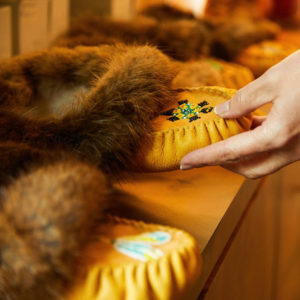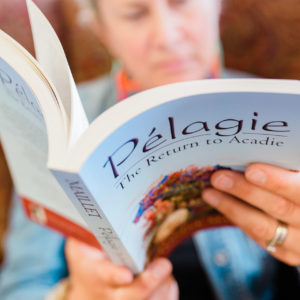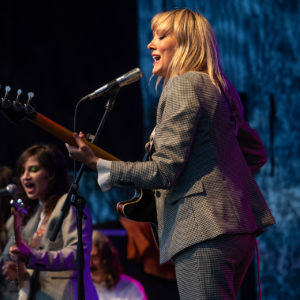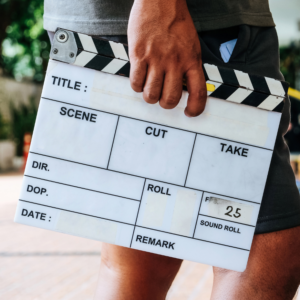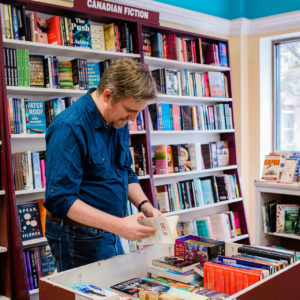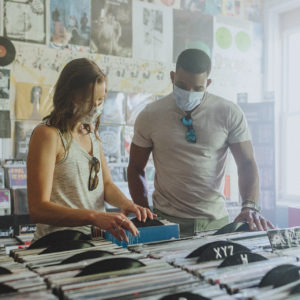
Karen LeBlanc
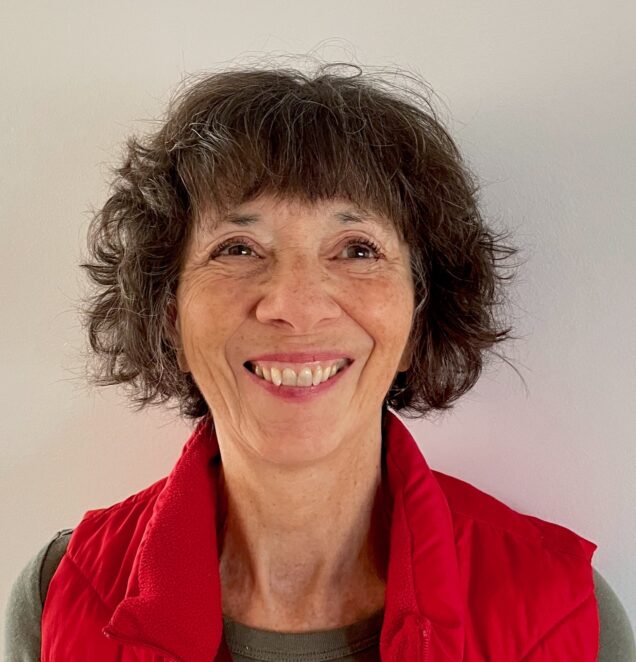
Karen LeBlanc is a weaver and fibre artist living in Fredericton, NB. Karen loves to weave traditional patterns and create her own weaving patterns. She also enjoys weaving tapestries and shaped vessels such as bowls and boxes.
Karen has participated in several residencies in Toronto, Parrsboro and Fredericton. She recently participated in the Conservation Council of New Brunswick’s Harm to Harmony (H2H) Residency (October 2023 – March 2024). For the H2H residency, Karen created and delivered a “Branch Out and Weave for Climate Change” workshop. After weaving on branches, Karen and the participants travelled to the Johnville Labyrinth Farm to scorch the branches in a fire pit. This project evolved from Karen’s “Burnt Earth” piece, which was woven, burnt in a ceramic pot, and then exhibited at the Mary E. Black Gallery in Halifax, NS in 2023.
In 2021, “Primary Colours Weave the Future” was installed as a public art commission at École Arc-en-ciel. In 2023, her “Suspended in Time: Woven Pages and Wooden Letters” was installed in the Hanwell Park Academy. In 2019, four woven wearables were part of the ArtWear fashion show and exhibition in Fort Collins CO. Her work has been exhibited in Reno NV, Milwaukee WI, Muskegon MI, New York NY, Toronto ON, Halifax NS, and many other galleries.
In 2023, Karen created a temporary outdoor fibre art installation with a large community engagement component during the Third Shift Festival in Saint John, NB. In 2023, Karen received an artsnb grant for “Bringing a Weaving Analogy Alive Through Fibre Art Sculpture,” consisting of nine woven hangings 24 inches wide and 20-24 feet long. This project is based on Karen’s M.Ed. thesis featuring a weaving analogy of transitions.
Karen is a member of several professional organizations: American Tapestry Alliance,
Handweavers Guild of America, CraftNB, Guild of Canadian Weavers, CraftNS, Fibre Arts Network and many more. In 2019, Karen retired from full-time employment with the Joint Economic Development Initiative (JEDI) where she obtained funding and managed workforce and economic development projects for Indigenous people in New Brunswick. Karen continues to advocate for Reconciliation with First Nations.
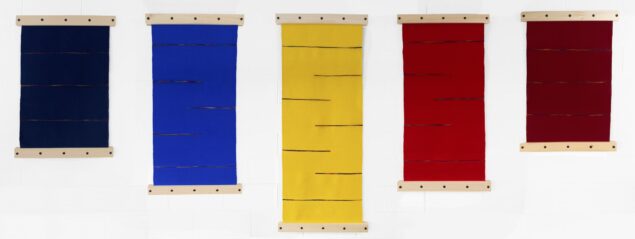
Primary Colours Weave the Future, 2021
A series of 5 handwoven tapestries in primary colours (dark blue, royal blue, yellow, light red and dark red). My design represents: rainbows; the Union Jack flag (dark blue, red, and white); the Canadian flag (red and white); the NB flag (yellow, red, blue, and white); and the Acadian flag (red, white, and royal blue with a yellow star). It also represents the Indigenous medicine wheel (red, yellow, white, and black).
This is installed at Arc-en-ciel School, Oromocto NB. Size: 169” wide x 61.5” long (at the longest point).
What led you to become an artist?
I have been a weaver for about 50 years. After a 10-year hiatus when I pursued higher education (BA, M.Ed.), I started working for a non-profit economic development organization in 2002 where I met a client selling a weaving loom. I bought the loom and have been weaving ever since. I learned many different weaving techniques since that time including tapestry weaving, Jacquard weaving, shaped weaving, and many other forms of weaving. I loved creating woven images on a Jacquard loom, which is where I really started to create more artistic woven pieces. However, it is very expensive to purchase a Jacquard loom. Since I love to play and experiment with yarns, fibres, textures, and techniques, I started to develop more art and fibre art in my work.
How did your training and experience help you to create and innovate in your artistic practice?
I learned to weave at the NB Craft School before it became a college. Meeting my Jacquard “guru”, Louise Lemieux Bérubé opened my eyes to new possibilities – not just with Jacquard weaving, but in mounting work for exhibitions, exhibiting work in galleries, and creating thematic works of fibre art.
What stimulates you most about your practice?
The ability to work with a variety of fibres, textures, patterns, and shapes to create cloth, but this “cloth” is more than just fabric. This cloth becomes a piece of art or a series of artwork.
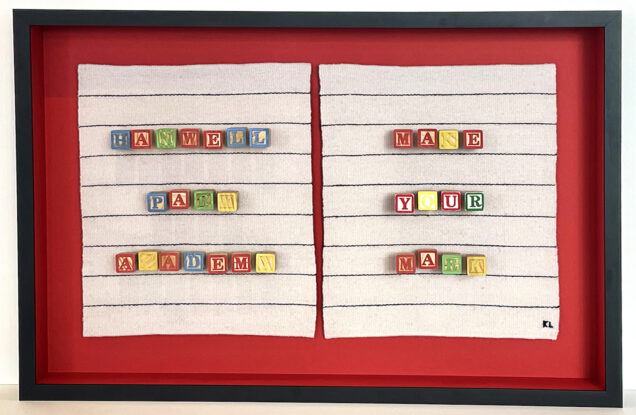
Suspended in Time, 2023
This piece is a public art commission installed at the Hanwell Park Academy. Two woven pieces represent looseleaf pages. I used vintage wooden alphabet blocks to spell “Hanwell Park Academy” and “Make Your Mark.” The blocks were mounted on coloured pencils inserted into the slits in the woven “pages”. A red matboard sets off the woven pieces and letters in a shadowbox frame. Size: 36” wide x 24” high x 4” deep
What drew you to textile works?
I have always loved textiles. I used to sew doll clothes and then I sewed my own clothes. In my early weaving career, I created woven clothing such as dresses, tops, tunics, jackets and much more. I love to create larger scale woven pieces for public art, exhibitions and other projects as well as “playing” with shaped woven pieces.
What motivates your creativity?
Many things motivate me. Sometimes I weave productive pieces such as scarves or shawls. Sometimes I’m inspired by an image I’ve seen online or in a magazine (I used to love Vogue magazines and would create handwoven garments). When I am working on an idea or concept for a public art, residency, grant, or other proposal, I can create basic images and/or mock-ups for a piece or series of pieces. These projects may have challenges and I’ve discovered that I love puzzles and solving problems and challenges. For “Primary Colours Weave the Future”, I designed and created a process for mounting the pieces so the pieces could be flipped from top to bottom or front to back as a method to prevent fading of the pieces. For the “Suspended in Time” piece, I had to revise my original proposal that included hanging vintage blocks in a large shadow box frame to inserting the vintage blocks in the weaving. A system of thick foamboard pieces were used to support the blocks that were mounted on coloured pencils in the frame. I love working out details like this, which is similar to my job as Senior Project Manager where I applied for large funding grants requiring annotated budgets and detailed descriptions of the projects.
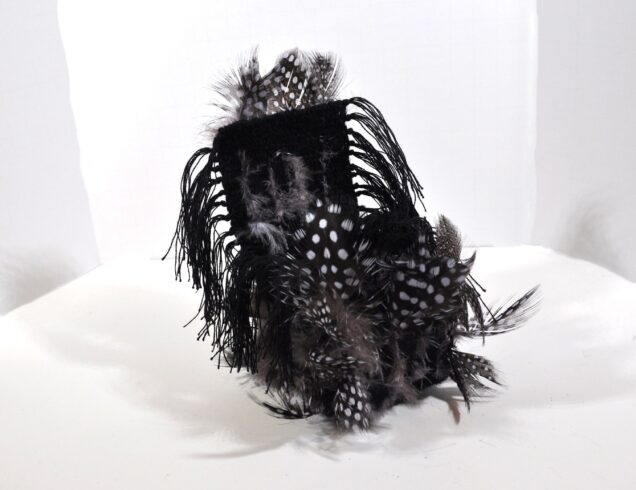
Black Bird Box, 2023
Backyard birds inspired me to create a little woven, shaped bird box with black and white polka-dot feathers woven into the weft. This little shaped bird-like box is completely handmade and shaped during the weaving process. The warp threads are knotted and are then untwisted to create feathery sides of the box.
How does your creative process unfold as you create an artwork?
It always depends on what project I am working on or a proposal that I am submitting. Once I have thought about the project, I tend to come up with concepts that I think will work in a specific space. For example, I had three different concepts for the Hanwell Park Academy public art project. When working on the proposal for each of the concepts, I had to be creative with my artwork, technical in the weaving process and practical in my delivery and installation processes.
Why do you think it's important to make art and pursue an artistic career?
One of the things I discovered about myself and my art during the pandemic is that creating art is how I process things and the world. Listening to the radio at that time brought disturbing news about the pandemic, climate change, the Black Lives Matter movement and then conflicts around the world (i.e. Russia invaded Ukraine). At the beginning of the pandemic, I felt gloom and doom. So I decided that I had to weave. I made a long colourful warp and started weaving. When I cut the warp off, I felt much better and then went on to my next project. I also successfully applied for my first public art project at that time. So, creating art helps me process life and keeps me sane!
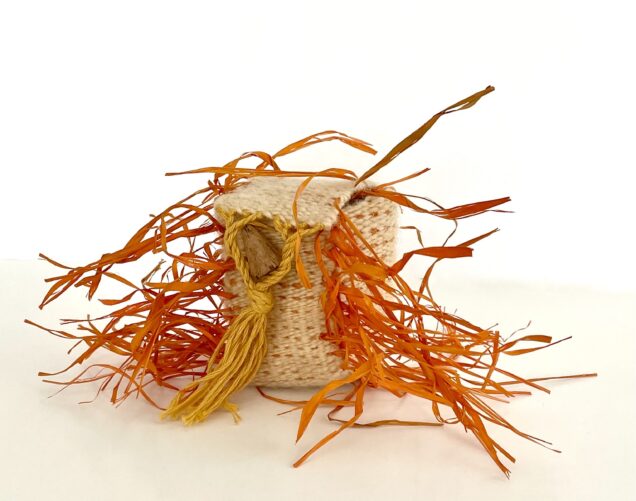
Woven Raffia and Handspun Box
The hand-dyed raffia erupts from this little handwoven, shaped box. Natural hand spun yarn creates texture in this fun little piece. After weaving the box, it is hand-stitched together. The warp threads along the top edge are twisted into two sections and knotted to create a hole for the wooden button closure.
What have you learned about yourself and the artistic community through your work?
I don’t have an art degree and I have never had an opportunity to study art, so when I retired from working full-time, I decided to apply to volunteer at the Beaverbrook Art Gallery. As a volunteer, I attend weekly volunteer guide meetings where volunteer guides learn about artists, artwork, art processes and art history. This has also helped me with my art practice and career by increasing my awareness of stories behind the artists and the art pieces that are found in the gallery. It has also helped me to present art to children and visitors at the gallery, which has ultimately helped me in how I present my art in proposals for public art, galleries, and exhibitions.
What do you think is the impact of artists' work on communities as a whole?
It varies – many people would not even notice artwork and/or would not be aware of the impact of galleries and public artwork. However, I believe there are many artists who try to increase awareness of art locally, regionally, nationally, and internationally. We live in a global economy now, so it is easy to connect with artists around the world who are making a difference in their small communities and globally!
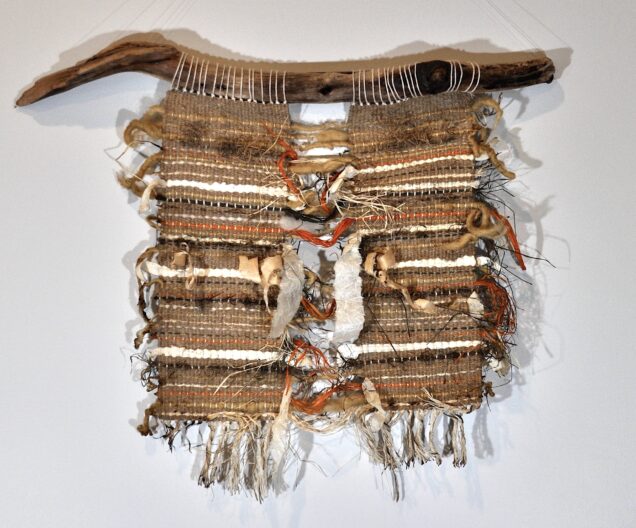
Burnt Earth, 2023
This piece was woven in response to the wildfires and relates to climate change. I created a split warp with cotton and used recycled jute, raffia, leather, hand spun wool yarn, wool roving, paper, wood shavings and leather for the weft. I left loose weft ends on the sides and between the woven pieces, fraying the raffia ends to create feathery effects. I set this piece on fire in a ceramic pot to bring awareness to climate change issues and the impacts on the environment. In 2023, Burnt Earth was exhibited at the Mary E. Black Gallery in Halifax, NS.
Describe what you are most proud of in your career.
I love the fact that I was invited to exhibit my 40 Welcomes piece at SOFA NY in 2012! This opportunity really started to open doors for me with galleries and exhibiting my artwork. Next, I am very proud of my public art pieces: Primary Colours Weave the Future, Suspended in Time: Woven Pages and Wooden Letters, and my current public art pieces for a new building in Nova Scotia. I was also delighted to create an outdoor temporary public art piece in Saint John last summer (in the rain!). Last year, I gave a Zoom presentation during Spinning and Weaving Week with the Handweaver’s Guild of America.
What advice would you give to young and emerging artists?
Create something every day and don’t be afraid to branch out and experiment and develop new ways of working and creating! And don’t worry about social media – creating is way more important! And keep sending project proposals in… if you are not successful the first few times, keep trying. I applied to artsnb many times (at least 10-12) before I successfully received a creation grant!
Where can we see/follow your work?
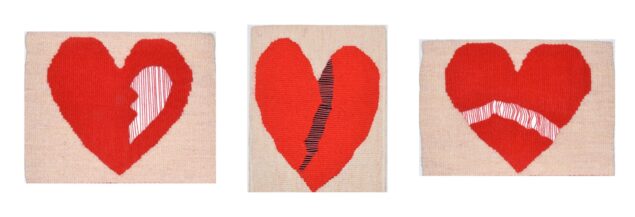
Heart String Triptych, 2020
For these three pieces, I used 4/8 red cotton for the warp and two-ply wool yarn in natural and red for the weft. I wanted to expose some of the red warp threads as part of the broken heart series. As the series came to life, the title evolved to “Heart Strings.” My perception is that a heart can feel like it’s made of strings at times. For the first piece (12.5” w x 9.75” h), the “strings” are exposed on the right side. This is hung with monofilament attached to a flat stick inserted in a panel on the back of the tapestry. For the middle or second piece (9” w x 12” h), I painted the canvas black and then stretched the tapestry over it to create a black background behind the “strings.” For the third piece (12.5” w x 9” h), the “strings” travel across the heart. This is hung as the first piece.
